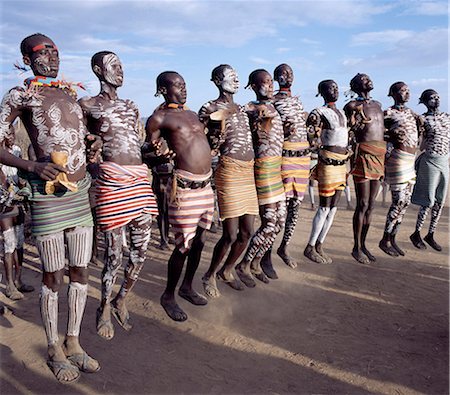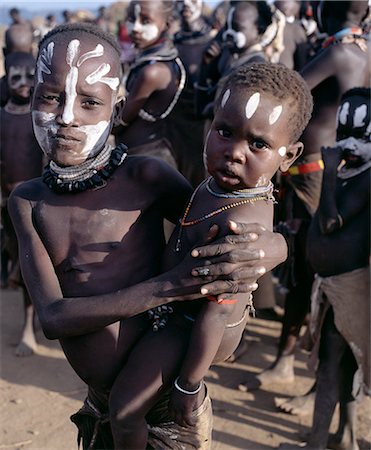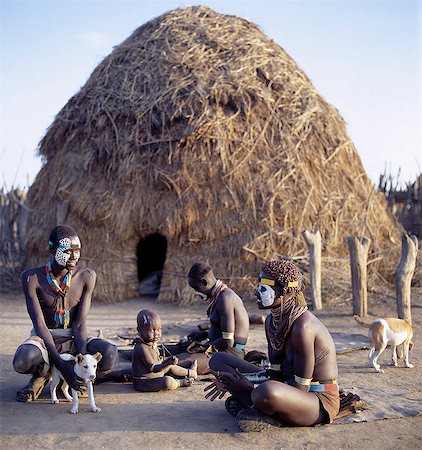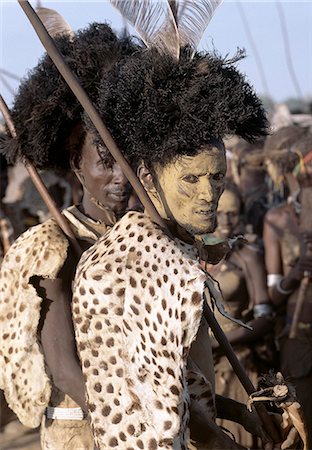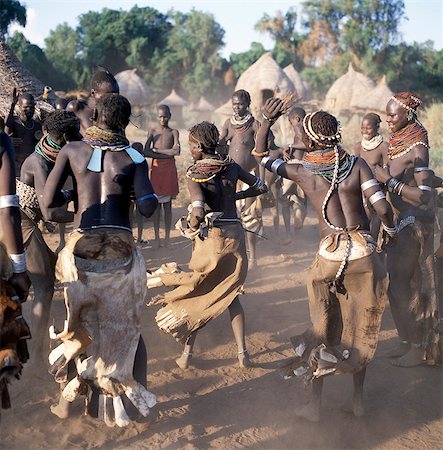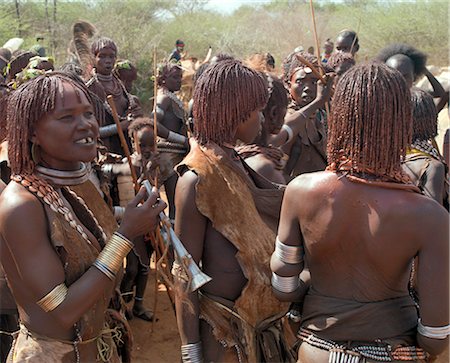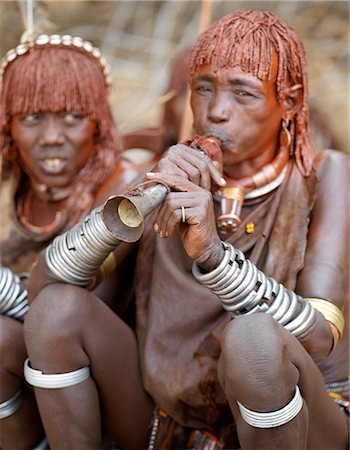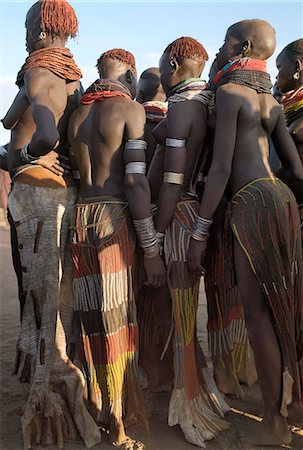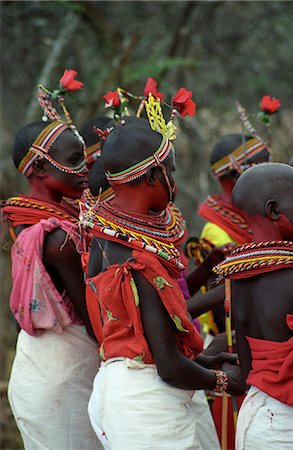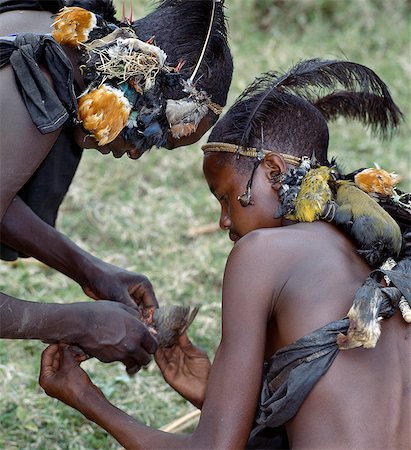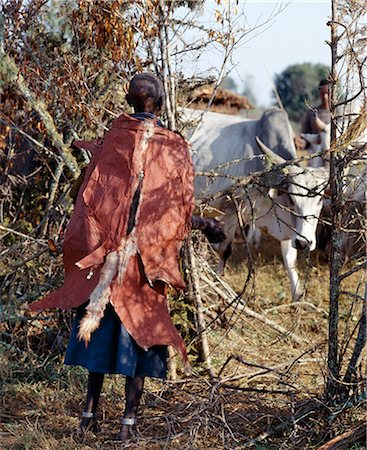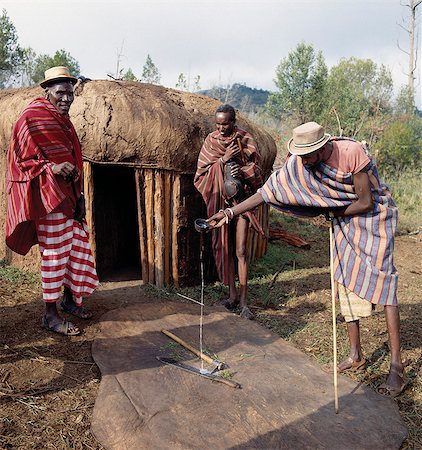-
Karo men excel in body art. Before a dance, they will decorate their faces and torsos elaborately using local white chalk, pulverised rock and other natural pigments. While older men style their hair with clay, young men prefer to braid theirs.Every man carries a wooden stool, which doubles as a pillow at night.The Karo are a small tribe living in three main villages along the lower reaches of the
Rights-Managed
-
Karo men excel in body art. Before a dance, they will decorate their faces and torsos elaborately using local white chalk, pulverised rock and other natural pigments. While older men style their hair with clay, young men prefer to braid theirs.Every man carries a wooden stool, which doubles as a pillow at night.The Karo are a small tribe living in three main villages along the lower reaches of the
Rights-Managed
-
Karo men excel in body art. Before a dance, they will decorate their faces and torsos elaborately using local white chalk, pulverised rock and other natural pigments. While older men style their hair with clay, young men prefer to braid theirs.Every man carries a wooden stool, which doubles as a pillow at night.The Karo are a small tribe living in three main villages along the lower reaches of the
Rights-Managed
-
The Karo of the Lower Omo River excel in body art. They decorate their faces and torsos elaborately using local white chalk, pulverised rock and other natural pigments. Even young children daub their faces before a dance.The Karo are a small tribe living in three main villages along the lower reaches of the Omo River in southwest Ethiopia.
Rights-Managed
-
In the late afternoon, family and friends sit outside a high dome roofed Karo home.The Karo excel in body art. Before a dance, they will decorate their faces and torsos elaborately using local white chalk, pulverised rock and other natural pigments. The polka dot or guinea fowl plumage effect is popular.
Rights-Managed
-
A Dassanech man in full tribal regalia participates in a dance during a month long ceremony. He wears a cheetah skin draped on his backs and a black ostrich feather headdress. He dances holding a long stick and a simulated shield.His face is smeared with mud giving him a singular appearance.
Rights-Managed
-
Men and women dance during a month long Dassanech ceremony. The men wear leopard, cheetah or serval cat skins draped on their backs and black ostrich feather headdresses. The women, dressed in skins, hang a single black and white colobus monkey skin down their backs.
Rights-Managed
-
A lively Nyangatom dance is enjoyed by villagers in the late afternoon.The elevated houses in the background are both homes and granaries, which have been built to withstand flooding when the Omo River bursts its banks The Nyangatom are one of the largest tribes and arguably the most warlike people living along the Omo River in Southwest Ethiopia.
Rights-Managed
-
Hamar women dance around cattle at a Jumping of the Bull ceremony as a rainbow gives colour to a threatening sky overhead.The Hamar are semi nomadic pastoralists of Southwest Ethiopia whose women wear striking traditional dress and style their red ochre hair mop fashion.The phallic protrusion of the women's chokers denote they are their husbands first wives.The Jumping of the Bull ceremony is a ri
Rights-Managed
-
A group of Hamar women at a Jumping of the Bull ceremony.The Hamar are semi nomadic pastoralists of Southwest Ethiopia whose women wear striking traditional dress and style their red ochred hair mop fashion.The Jumping of the Bull ceremony is a rite of passage for young men.
Rights-Managed
-
A Hamar woman holds a tin trumpet at a Jumping of the Bull ceremony.The Hamar are semi nomadic pastoralists of Southwest Ethiopia whose women wear striking traditional dress and style their red ochred hair mop fashion.The Jumping of the Bull ceremony is a rite of passage for young men.
Rights-Managed
-
A Hamar woman blows a tin trumpet at a Jumping of the Bull ceremony.The Hamar are semi nomadic pastoralists of Southwest Ethiopia whose women wear striking traditional dress and style their red ochred hair mop fashion.The Jumping of the Bull ceremony is a rite of passage for young men.
Rights-Managed
-
A Hamar woman blows a tin trumpet at a Jumping of the Bull ceremony.The Hamar are semi nomadic pastoralists of Southwest Ethiopia whose women wear striking traditional dress and style their red ochred hair mop fashion.The Jumping of the Bull ceremony is a rite of passage for young men.
Rights-Managed
-
Hamar men line up steers at a Jumping of the Bull ceremony.The semi nomadic Hamar of Southwest Ethiopia embrace an age grade system that includes several rites of passage for young men.After the ceremony, the initiate attains full manhood and is permitted to marry
Rights-Managed
-
A Hamar woman implores a man to whip her at a Jumping of the Bull ceremony.Female friends and relatives of the initiate are willing whipped with pliable sticks to show their solidarity and love for him. They do not flinch or show any sign of pain.The semi nomadic Hamar of Southwest Ethiopia embrace an age grade system that includes several rites of passage for young men.
Rights-Managed
-
In the late afternoon, Nyangatom villagers enjoy singing and dancing. As groups of men take centre stage to jump high in the air, women and girls sing, clap to a rhythm, and move slowly towards the men. Children enjoy the excitement in the background.The Nyangatom are one of the largest tribes and arguably the most warlike people living along the Omo River in Southwest Ethiopia.
Rights-Managed
-
With oiled and blackened bodies, a group of young men who have already completed their initiation ceremony participate in a Hamar Bull Jumping ceremony of a friend by circling the cattle before the climax to the ceremony takes place.After the ceremony, the initiate attains full manhood and is permitted to marry
Rights-Managed
-
A Hamar woman being whipped by a man at a Jumping of the Bull ceremony.The semi nomadic Hamar of Southwest Ethiopia embrace an age grade system that includes several rites of passage for young men.
Rights-Managed
-
A group of Nyangatom girls and women with beautifully decorated leather skirts gather to dance.The Nyangatom are one of the largest tribes and arguably the most warlike people living along the Omo River in Southwest Ethiopia.
Rights-Managed
-
A group of Nyangatom girls and women with beautifully decorated leather skirts gather to dance.The Nyangatom are one of the largest tribes and arguably the most warlike people living along the Omo River in Southwest Ethiopia.
Rights-Managed
-
A Hamar woman dances around cattle while she blows a tin trumpet at a Jumping of the Bull ceremony.The Hamar are semi nomadic pastoralists of Southwest Ethiopia whose women wear striking traditional dress and style their red ochred hair mop fashion.The Jumping of the Bull ceremony is a rite of passage for young men.
Rights-Managed
-
Hamar women dance at a Jumping of the Bull ceremony.The Hamar are semi nomadic pastoralists of Southwest Ethiopia whose women wear striking traditional dress and style their red ochred hair mop fashion. The Jumping of the Bull ceremony is a rite of passage for young men.After the ceremony, the initiate attains full manhood and is permitted to marry.
Rights-Managed
-
With whipping sticks in their hands, men crouch as they bless an initiate who is about to perform his Jumping of the Bull ceremony.The Hamar are semi nomadic pastoralists of Southwest Ethiopia who embrace an age grade system that includes several rites of passage for young men.
Rights-Managed
-
A Hamar woman blows a tin trumpet at a Jumping of the Bull ceremony.The Hamar are semi nomadic pastoralists of Southwest Ethiopia whose women wear striking traditional dress and style their red ochred hair mop fashion.The Jumping of the Bull ceremony is a rite of passage for young men.
Rights-Managed
-
A Hamar woman at a Jumping of the Bull ceremony.The Hamar are semi nomadic pastoralists of Southwest Ethiopia whose women wear striking traditional dress and style their red ochred hair mop fashion.The Jumping of the Bull ceremony is a rite of passage for young men.
Rights-Managed
-
A Karo woman with her face painted in preparation for a dance in the village of Duss. A small Omotic tribe related to the Hamar, who live along the banks of the Omo River in southwestern Ethiopia, the Karo are renowned for their elaborate body painting using white chalk, crushed rock and other natural pigments. She is wearing a goatskin apron and carries a leather belt decorated with cowrie shells
Rights-Managed
-
A Karo women stands in the doorway to her hut in the village of Duss. A small Omotic tribe related to the Hamar, who live along the banks of the Omo River in southwestern Ethiopia, the Karo are renowned for their elaborate body painting using white chalk, crushed rock and other natural pigments. In addition to painting her face she has decorated her body with whorls of goat hair tied by leather co
Rights-Managed
-
Karo men excel in body art. They decorate their faces and torsos elaborately using local white chalk, pulverised rock and other natural pigments.While young men prefer to braid their hair, older men style their hair with clay, which they colour and decorate with ostrich feathers.The Karo are a small tribe living in three main villages along the lower reaches of the Omo River in southwest Ethiopi
Rights-Managed
-
Karo men excel in body art. They decorate their faces and torsos elaborately using local white chalk, pulverised rock and other natural pigments. Their braided hairstyles are typical of young men from the tribe.The Karo are a small tribe living in three main villages along the lower reaches of the Omo River in southwest Ethiopia.
Rights-Managed
-
A Mursi woman wearing a large wooden lip plate. Shortly before marriage, a girls lower lip will be pierced and progressively stretched over a year or so. The size of the lip plate often determines the quantum of the bride price. They live in a remote area of southwest Ethiopia along the Omo River.
Rights-Managed
-
Two Mursi men with singular hairstyles play a game of bau as a young boy watches them. Most men possess rifles to protect their families from hostile neighbours.Body art is an important aspect of Mursi culture.They live in a remote area of southwest Ethiopia along the Omo River.
Rights-Managed
-
A Mursi woman wearing a large clay lip plate. Shortly before marriage, a girls lower lip will be pierced and progressively stretched over a year or so. The size of the lip plate often determines the quantum of the bride price. They live in a remote area of southwest Ethiopia along the Omo River, the country's largest river.
Rights-Managed
-
Shaded from the hot sun, a Karo woman grinds sorghum using large flat stones.It is customary for females of the tribe when in their teens to make a small hole in the flesh below their lower lips into which they put an ornament, this woman has used a small nail. Numerous heavy metal bracelets are worn by married womenThe Karo are a small tribe living in three main villages along the lower reaches o
Rights-Managed
-
Karo men excel in body art. They decorate their faces and torsos elaborately using local white chalk, pulverised rock and other natural pigments. Their braided hairstyles are typical of young men from the tribe.The Karo are a small tribe living in three main villages along the lower reaches of the Omo River in southwest Ethiopia.
Rights-Managed
-
Karo men excel in body art. They decorate their faces and torsos elaborately using local white chalk, pulverised rock and other natural pigments. Their braided hairstyles are typical of young men from the tribe.The Karo are a small tribe living in three main villages along the lower reaches of the Omo River in southwest Ethiopia.
Rights-Managed
-
During Samburu wedding celebrations,warriors resplendent with long Ochred braids dance with young girls who have put on all their finery for the occasion. Both warriors and girls smear their faces,necks and shoulders with red ochre mixed with animal fat to enhance their appearance. Two spears are tipped with ostrich-feather pompoms.
Rights-Managed
-
Samburu initiates sing during the month after their circumcision. As their wounds heal, their dances become more energetic. Before long, they imitate the dances of the warriors which, hitherto, they have been forbidden to perform.They spend much of their time wandering in the countryside attempting to kill as many birds as they can with a club and four blunt arrows. When a bird is killed, it is sk
Rights-Managed
-
A Karo mother and child. Heavy metal bracelets are common among older women.The Karo are a small tribe living in three main villages along the lower reaches of the Omo River in southwest Ethiopia.
Rights-Managed
-
The invited guests at a Samburu wedding gather together to sing in praise of the couple and to dance. Celebrations will go on late into the night.
Rights-Managed
-
Two young Karo girls stand in front of the massive trunk of a fig tree. A small Omotic tribe related to the Hamar,who live along the banks of the Omo River in southwestern Ethiopia,the Karo are renowned for their elaborate body painting using white chalk,crushed rock and other natural pigments.
Rights-Managed
-
A Samburu boy the day before his circumcision.He has daubed the right side of his face and body with white clay while drawing water from a source that never dries up. Each boy will carry for this purpose a new gourd shaped container made by his mother from hollowed out wood.
Rights-Managed
-
An old Dassanech man wearing a traditional metal lip ornament and metal earrings. His broad ivory armbands and his ivory tobacco container hanging round his neck, are uncommon because elephants no longer frequent the Omo Delta.The Dassanech people live in the Omo Delta of southwest Ethiopia, one of the largest inland deltas in the world.
Rights-Managed
-
A young Karo girl in the doorway of her hut in the village of Duss. A small Omotic tribe related to the Hamar,who live along the banks of the Omo River in southwestern Ethiopia,the Karo are renowned for their elaborate body painting using white chalk,crushed rock and other natural pigments.
Rights-Managed
-
An elder of the Karo tribe,a small Omotic tribe related to the Hamar,who live along the banks of the Omo River in southwestern Ethiopia. The Karo are renowned for their elaborate body painting using white chalk,crushed rock and other natural pigments. This man also has a clay hairdo typical of tribal elders. Like most adult males he carries a rifle.
Rights-Managed
-
Mothers rub animal fat into their sons cloaks to make them supple. This task is performed shortly before the boys set out on an arduous journey to collect sticks, staves and gum to make bows, blunt arrows and clubs after their circumcision.
Rights-Managed
-
In the late afternoon, Nyangatom villagers enjoy singing and dancing. As groups of men take centre stage to jump high in the air, women and girls sing, clap to a rhythm, and move slowly towards the men. Children enjoy the excitement in the background.The Nyangatom are one of the largest tribes and arguably the most warlike people living along the Omo River in Southwest Ethiopia.
Rights-Managed
-
A Dassanech elder wearing a traditional clay hairdo, topped with ostrich feathers. His broad beaded necklace is unusual for its size but his five brass earrings are a common decoration of both men and women.The Dassanech people live in the Omo Delta of southwest Ethiopia, one of the largest inland deltas in the world.
Rights-Managed
-
Gabbra women sing and dance to celebrate a wedding. The traditional metal ornamentation on their heads is called malmal.
Rights-Managed
-
A Karo woman wears an elaborate headdress made from the wing-cases of beetles and a cape of calf skin fringed with cowrie shells. A small Omotic tribe related to the Hamar,who live along the banks of the Omo River in southwestern Ethiopia,the Karo are renowned for their elaborate body painting using white chalk,crushed rock and other natural pigments.
Rights-Managed
-
A Karo woman wears an elaborate headdress made from the wing-cases of beetles and a cape of calf skin fringed with cowrie shells. A small Omotic tribe related to the Hamar,who live along the banks of the Omo River in southwestern Ethiopia,the Karo are renowned for their elaborate body painting using white chalk,crushed rock and other natural pigments.
Rights-Managed
-
Kenya, Samburu District. A tourist attempting to jump as high as a Samburu warrior, in the dry river bed of the Ewaso Nyiro.
Rights-Managed
-
Kenya, Samburu District. Samburu warriors and young girls sing and dance in the dry river bed of the Ewaso Nyiro River.
Rights-Managed
-
Karo men paint each other in preparation for a dance in the village of Duss. A small Omotic tribe related to the Hamar,who live along the banks of the Omo River in southwestern Ethiopia,the Karo are renowned for their elaborate body painting using white chalk,crushed rock and other natural pigments.
Rights-Managed
-
A Datoga woman relaxes outside her thatched house.The traditional attire of Datoga women includes beautifully tanned and decorated leather dresses and coiled brass armulets and necklaces. Extensive scarification of the face with raised circular patterns is not uncommon among women and girls.
Rights-Managed
-
Gabbra women dance at a gathering in the village of Kalacha. The Gabbra are a Cushitic tribe of nomadic pastoralists living with their herds of camels and goats around the fringe of the Chalbi Desert.
Rights-Managed
-
Gabbra women dance at a gathering in the village of Kalacha. The Gabbra are a Cushitic tribe of nomadic pastoralists living with their herds of camels and goats around the fringe of the Chalbi Desert.
Rights-Managed
-
Gabbra women sing and dance to celebrate a wedding. The traditional metal ornamentation on their heads is called malmal.
Rights-Managed
-
Song is an art form ingrained in Turkana culture. At the end of a dance session,the participants invariably enjoy the Song of the Bulls. Each young man will take centre-stage to extol the praises of his favourite ox. He will explain how it came into his possession,its distinguishing traits and with outstretched arms,imitate the shape of its horns.
Rights-Managed
-
Song is an art form ingrained in Turkana culture. At the end of a dance session,the participants invariably enjoy the Song of the Bulls. Each young man will take centre-stage to extol the praises of his favourite ox. He will explain how it came into his possession,its distinguishing traits and with outstretched arms,imitate the shape of its horns.
Rights-Managed
-
Song is an art form ingrained in Turkana culture. After months of separation,young men and girls gather together during the rains when grass is abundant and life is relatively easy for a while. The Turkana have a rich repertoire of at least twenty dances,most of which are quite energetic.
Rights-Managed
-
Song is an art form ingrained in Turkana culture. At the end of a dance session,the participants invariably enjoy the Song of the Bulls. Each young man will take centre-stage to extol the praises of his favourite ox. He will explain how it came into his possession,its distinguishing traits and with outstretched arms,imitate the shape of its horns.
Rights-Managed
-
During Samburu wedding celebrations,married women congregate apart from the warriors and young girls to sing in praise of the couple and to dance.
Rights-Managed
-
During Samburu wedding celebrations,married women congregate apart from the warriors and young girls to sing in praise of the couple and to dance.
Rights-Managed
-
Maasai girls gather to celebrate a wedding. Their broad beaded necklaces with predominantly white glass beads mark then as Kisongo Maasai,the largest clan group of the tribe which lives either side of the Kenya-Tanzania border.
Rights-Managed
-
A Dassanech girl braids her sister's hair at her village in the Omo Delta. Much the largest of the tribes in the Omo Valley numbering around 50,000,the Dassanech (also known as the Galeb,Changila or Merille) and Nilotic pastoralists and agriculturalists.
Rights-Managed
-
A Datoga woman relaxes outside her thatched house.The traditional attire of Datoga women includes beautifully tanned and decorated leather dresses and coiled brass armulets and necklaces.The Datoga live in northern Tanzania and are primarily pastoralists.
Rights-Managed
-
A Mursi woman wearing a large clay lip plate and ear ornaments to match.Shortly before marriage, a girls lower lip will be pierced and progressively stretched over a year or so while some of her teeth will be removed for the plate to fit snugly.The size of the lip plate often determines the quantum of the bride price. The reason for this singular practice is not fully understood but Mursi women
Rights-Managed
-
A Mursi woman wearing a large clay lip plate and ear ornaments to match.Shortly before marriage, a girls lower lip will be pierced and progressively stretched over a year or so while some of her teeth will be removed for the plate to fit snugly.The size of the lip plate often determines the quantum of the bride price. The reason for this singular practice is not fully understood but Mursi women
Rights-Managed
-
A Nyangatom woman wears multiple layers of beads in necklaces, an elaborately beaded calfskin skirt and metal bracelets, amulets and anklets. She is standing beside a temporary beehive construction of sticks, grass and leaves built to provide shade for her goats. The Nyangatom or Bume are a Nilotic tribe of semi-nomadic pastoralists who live along the banks of the Omo River in south western Ethio
Rights-Managed
-
Dressed in his black goatskin cloak,a Samburu boy puts his bundle of sticks,staves and gum on the roof of his mother's house. He has collected these with other boys from a special type of Commiphora tree during an arduous journey on foot of up to 200 miles. After his circumcision,he will make them into bows,blunt arrows and clubs.
Rights-Managed
-
Black clothing and the intricate white patterns on the face of this Maasai youth of the Kisongo section signify his recent circumcision.
Rights-Managed
-
Black clothing,Black ostrich feathers and the intricate white patterns on the face of this Maasai youth of the Kisongo section signify his recent circumcision.
Rights-Managed
-
A Karo woman sits with child. A small Omotic tribe related to the Hamar,who live along the banks of the Omo River in southwestern Ethiopia,the Karo are renowned for their elaborate body painting using white chalk,crushed rock and other natural pigments. Typically for a Karo woman,the mother has ochred her hair in tight ringlets and has a ring through her bottom lip.
Rights-Managed
-
An elder of the Karo tribe sits with his wife and child. A small Omotic tribe related to the Hamar,who live along the banks of the Omo River in southwestern Ethiopia,the Karo are renowned for their elaborate body painting using white chalk,crushed rock and other natural pigments. This man also has a clay hairdo typical of tribal elders. Like most adult males he carries a rifle.
Rights-Managed
-
Samburu initiates skin a bird without the use of a knife.While their wounds heal for a month after circumcision, initiates spend their time wandering in the countryside attempting to kill as many birds as they can with a club and four blunt arrows. When a bird is killed, it is skinned, stuffed with dry grass and attached to the boy's headband by means of its beak.
Rights-Managed
-
A Samburu initiate takes aim at a bird with a blunt arrow.While their wounds heal for a month after circumcision, initiates spend their time wandering in the countryside attempting to kill as many birds as they can with a club and four blunt arrows. When a bird is killed, it is skinned without a knife, stuffed with dry grass and attached to the boys headband by means of its beak.
Rights-Managed
-
Kenya, South Horr, Kurungu.A Samburu youth after his circumcision. The day after he has been circumcised, the initiate must hang in his pierced earlobes copper ear ornaments that are normally worn by married women. His sponsors make him a new headdress of ostrich feathers fastened to a narrow band of plaited fibre, which fits tightly round his forehead like a sweatband.
Rights-Managed
-
A Samburu mother shaves her sons head outside her home the day before he is circumcised.Round her neck hangs his nchipi, the distinctive decoration of every boy who participates in the circumcision ritual. The strings of blue beads terminate in large bronze coloured wings of a torpedo shaped beetle, Sterocera hildebrandti.
Rights-Managed
-
A Samburu boy in reflective mood after his circumcision.A day after the ordeal, he will hang in his pierced earlobes copper earrings normally worn by married women and put on a new headdress of ostrich feathers fastened to a narrow band of plaited fibre, which fits tightly round his forehead.
Rights-Managed
-
A Mursi woman wearing a large clay lip plate and ear ornaments to match.Shortly before marriage, a girls lower lip will be pierced and progressively stretched over a year or so while some of her teeth will be removed for the plate to fit snugly.The size of the lip plate often determines the quantum of the bride price. The reason for this singular practice is not fully understood but Mursi women
Rights-Managed
-
A Mursi woman with decorated face and body scarification wears a large clay lip plate. Shortly before marriage, a girls lower lip will be pierced and progressively stretched over a year or so while some of her teeth will be removed for the plate to fit snugly.The size of the lip plate often determines the quantum of the bride price.The reason for this singular practice is not fully understood but
Rights-Managed
-
A young Nyangatom woman carries her baby on her hip in an elaborately braided papoose. Her hair has been reddened with a mixture of ochre and animal fat. Typical of her tribe, she wears a calfskin skirt, multiple layers of bead necklaces and metal bracelets and amulets. The Nyangatom or Bume are a Nilotic tribe of semi nomadic pastoralists who live along the banks of the Omo River in south western
Rights-Managed
-
A Nyangatom woman stands with her baby on her hip beside her grass hut in his temporary camp. Nyangatom married women wear elaborately beaded skirts which reach the ground at the back and often have panels of different coloured calkfskin sewn into the tail The Nyangatom or Bume are a Nilotic tribe of semi nomadic pastoralists who live along the banks of the Omo River in south western Ethiopia.
Rights-Managed
-
The evening before a Samburu boy is circumcised,he must lean over his mother under a special ochred goatskin cape as she milks a cow that has not given birth more than twice. This milk will be kept overnight in a traditional wooden gourd-like container and will be poured over the boy's head just before he is circumcised early the next morning.
Rights-Managed
-
A Samburu mother wears an ochred goatskin cape ready for milking a cow the evening before her son is circumcised. This distinctive cape is worn only at circumcision ceremonies. The milk must be drawn from a cow that has not given birth more than twice and will be poured over her son's head just before he is circumcised early the next morning.
Rights-Managed
-
The day before Samburu boys are circumcised in their lorora,(a purpose-built circumcision encampment),senior elders will bless the sharp instruments of every household,such as pangas and axes,by pouring a little milk over them as they intone a blessing. The instruments must be laid out on the oxhide upon which the boy of each household will be circumcised.
Rights-Managed
